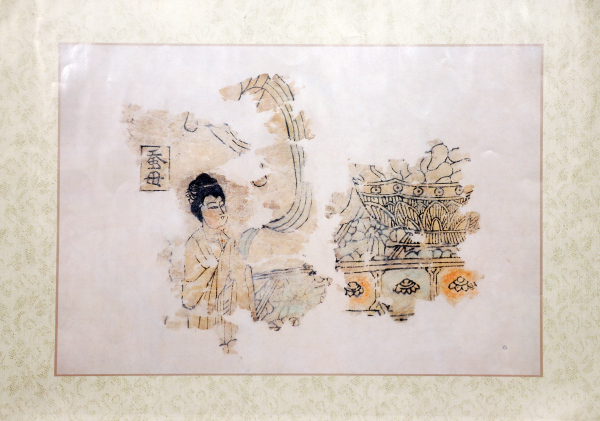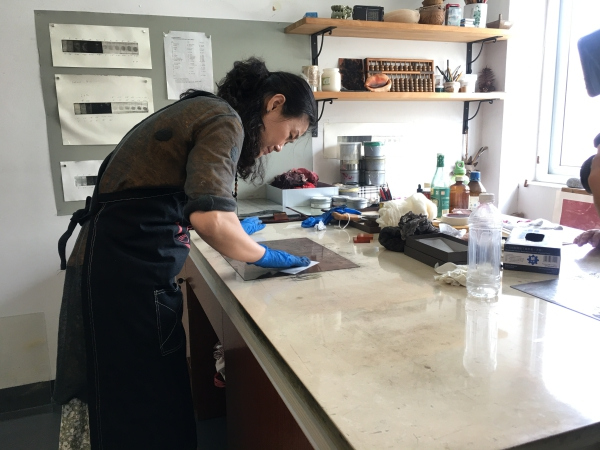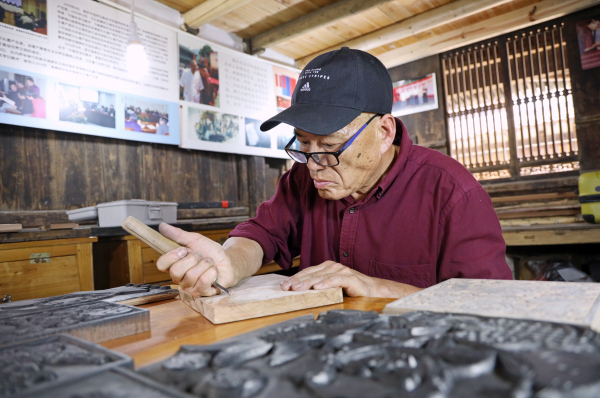In the history exhibition hall of Wenzhou Museum, one exhibit stands out from all other counterparts in the room. While this one, a woodprint in multiple colors that features a silkworm lady and dates back to the Northern Song (960-1127), is a replica, all the others are authentic. This woodprint is titled Silkworm Lady. The original is too precious to be on show for fear that long-term exposure to ultraviolet could damage the treasured paper.
The chromatic woodprint is precious partly because this is China’s extant earliest woodprint in color and partly because it showcases the history of sericulture in Wenzhou.

Silkworm Lady was discovered in 1994 when experts of Wenzhou Museum were sorting out a batch of books and prints, in seriously damaged conditions, discovered in the stone pagoda from Guo’an Temple. The pagoda stands on the top of Five-Peak Mountain in Longwan District of Wenzhou. In 1987, a restoration project, funded by the provincial administration of cultural heritage, was launched. A stone stele, discovered in the restoration, indicates the pagoda was built from 1090 to 1093, which were the years of the Northern Song. The chromatic woodprint was discovered in a square stone alcove on the third floor of the pagoda. A stone stele in the alcove is dated 1091. It is therefore assumed that the woodprint was produced no later than 1093 when the pagoda was done with construction.
Part of the woodprint is damaged, but the damage does not prevent the print from showing what it is. The print presents a standing image of Silkworm Lady, which was the name for goddess of silkworm. Inside a small rectangle in the upper left corner are two Chinese words 蚕母, which means goddess of silkworm. The rest of the print shows cocoons and other auspicious images. This print showcases the image of silkworm lady and a bumper harvest of cocoons.

Stone and pottery spinning wheels excavated from ancient sites in Wenzhou reveal that sericulture in the region can date back to prehistoric periods. A paste-on-paste decoration on a primitive pottery, which was unearthed from an ancient tomb that can be traced back at least to the Spring and Autumn period (770-476BC), presents a pattern of silkworm. Before the Tang Dynasty (618-907), silkworm farmers could produce eight rounds of cocoons a year. Silk weaving and embroidery were quite advanced in Wenzhou.
Woodprint as an art appeared in China five hundred years earlier than in Europe. Some murals in caves and temples before the Sui Dynasty (581-617) were colored. In the Tang, the block printing technology appeared and made book printing into a reality. Chromatic woodprints also appeared, using a variety of techniques. Generally, there were two major coloring techniques: in one way, a set of carved printing blocks was used, each block for one single color; in the other, one single block was used repeatedly for printing different colors.

Whether the woodprint of Lady Silkworm in the collection of the museum was printed in Wenzhou is unknown, but Wenzhou does have at least one master who carries on an ancient woodprint technology. The 63-year-old Wang Xunqiao is a master of movable-type printing and woodprint. He is a native of Dongyuan Village where the ancient movable-type printing technology is still alive. In Rui’an, a county-level city of Wenzhou, there are eleven such masters who still use the technology to print genealogy books for local clans. Of the eleven, Wang is the only one who is also a master of woodprint technology. At 18 he began to study the movable-type printing under the guidance of his great uncle. After he got married, he studied the woodprint technology from relatives of his wife’s family. Woodprints he learned and mastered include some prints and “hell money” largely burnt in folk ceremonies. The woodprint technology was first carried to Rui’an from Fujian in the 17th century and was inscribed onto the list of intangible cultural heritage of Zhejiang Province in 2014.
Wang Xunqiao is not confined to producing hell-money to be used in sacrifices and ceremonies. With some new techniques he has mastered, he is working to produce woodprints featuring subject matters that are artistic and decorative.





